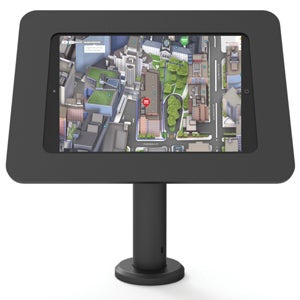Tech options abound for digital wayfinding
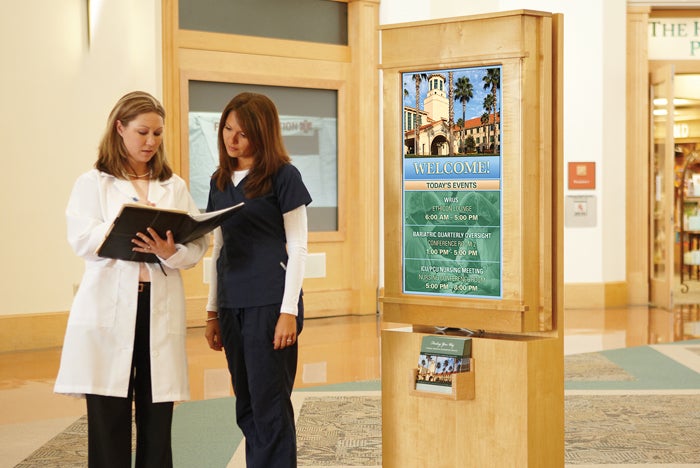
As health care facilities become more complex, facility professionals are being challenged more than ever to provide new wayfinding solutions for visitors, patients and staff. Luckily, vendors have developed digital wall signage, digital wayfinding kiosks and hand-held/mobile digital wayfinding solutions to help people better navigate these environments.
Among the latest trends, digital wall signage is coming down in price, becoming more compact in design, and utilizing wireless and cloud-based networking and communications over traditional network setups. “This offers great advantages to facilities by reducing the impact and cost related to infrastructure setup when installing new signage systems,” says Chris Douma, senior sales operations manager, 2/90 Sign Systems, Grand Rapids, Mich.
Recently, 2/90 Sign Systems developed a solution that includes a digital display and an architectural sign all in one unit, giving hospitals the ability to include digital signage content while maintaining their architectural signage standards. “Architectural signage and digital signage do not have to be in conflict. In fact, the best signage programs utilize both mediums together to successfully communicate with the user,” Douma says.
As for wayfinding kiosks, freestanding and wall-mounted directories can effectively convey massive amounts of information in manageable bites. They also can address multilingual and Limited English Proficiency needs. “Where they break down is on content and upkeep,” says Randy Cooper, SEGD DSE, president, Cooper Signage & Graphics Inc., Loganville, Ga. “Facilities administrators are reluctant to enter into multiyear maintenance and content management agreements and the software/hardware and content can quickly go out of date.”
While standard digital kiosks represent most of the wayfinding solutions implemented within hospitals, the trend has been moving toward empowering patients and visitors with more information available via mobile applications, says Angel Newsom, health care consultant, Four Winds Interactive (FWI), Denver. “The goal for the hospital should be to have a variety of tools to serve patients’ needs — from planning their visit to having GPS-style directions that take them from home to site, to the correct parking location and to the destination.”
Personalized engagement
New technologies allow users to personalize the information. “Touch-screen menus allow people to send maps and routes to their smartphones,” says Lillyan Wamaitha, marketing manager, Mvix Digital Signage, Sterling, Va. “Dynamic data such as doctor bios can be added to the kiosks, and meeting agendas can be added for a comprehensive yet intimate wayfinding experience.”
To make this happen, self-navigation in complex spaces requires unified, simplistic terminology; straightforward physical addresses for destinations; and preferred pathways with defined waypoints along the way. “Only then can facilities managers develop a comprehensive approach, and the right mix of communicative tools, that responds to the needs of patients and families,” Cooper notes.
Among the challenges that hospitals pose, the biggest issue for digital wayfinding systems today revolves around cell service, experts agree. Hospitals are large, complex campuses with seemingly endless interior hallways and rooms. In these hallways, cell service can be hard to come by, resulting in limited service, which skews most wayfinding applications.
The challenges posed by hospitals are not technical wayfinding challenges, says Joshua Titus, CEO and founder, Gozio Health, Atlanta. “We have the technology to achieve accurate indoor navigation of complex health care facilities with satellite locations. The challenge is that innovation is not always embraced by hospital culture. As that culture shifts to one that embraces innovation to their benefit, more hospitals will choose mobile wayfinding.”
Geo-location and real-time locating systems (RTLS) technologies are becoming more important in hospital wayfinding. “Geo-fencing, beacons and other real-time location services are at the higher end of the spectrum but are great options. In a cost-sensitive, maturing market, we expect to see price points and offerings improve significantly over the next five years,” Cooper says.
While geo-location and RTLS will continue to play an important role in hospital wayfinding, the accuracy of these services presents a challenge, according to Brian Rehkopf, senior account executive, health care, concept3D Inc., Denver. “As wearable devices — such as the Apple Watch with haptic direction indicators — become more common, there’s a lot that can be done to help people navigate spaces. However, with greater use of geo-location and RTLS, digital wayfinding kiosks will remain an important tool for hospitals as part of a complete wayfinding solution.”
Maximizing data
Data collection is a key component of digital wayfinding and can be used for planning signage programs. “The investment required up front to deploy a digital signage system — such as programming, content mapping and medium development of screen layouts and templates — makes proper data collection even more important,” Douma says.
Rehkopf says that data collection is vital to maximizing the potential of a hospital’s wayfinding engine. “Knowing how people use it — when, why and to what extent — allows our clients to customize the experience for the user. Data — for example, most popular locations and search results — can help facilities managers to determine areas where they need to improve wayfinding and general people movement such as physical signs, highlighting the fastest ways in and out of a building, and floor-plan layouts.”
Small, off-campus health care facilities pose some challenges to digital signage providers, but one that is easily solved with careful planning.
“We’ve found that the key to successful wayfinding implementation is providing a consistent overall experience across the network,” says Monica Nowac, client service director, LogicJunction Inc., Beachwood, Ohio. “However, the level of detail needed at smaller facilities may not be necessary.”
Nowac describes her company’s approach to handling a multifacility project. “Our solution can be used to provide overall directions for the entire hospital network, including off-site facilities, ensuring that patients and visitors arrive at the correct location for their appointment or procedure. We accomplish this by embedding our web-based software within the hospital’s locations-and-directions web page in addition to strategically placing hyperlinks throughout, providing a consistent search experience for in-hospital directions.”
Next, LogicJunction considers the size and complexity of the sister facility to determine if a kiosk or tablet [to run interactive wayfinding software] is needed at the main entrance or other common areas. If wayfinding software is not required, it can be added later. “Lastly, we train patient-facing employees to use the wayfinding software. Information desk staff and volunteers at off-site locations often use our web platform to print or email personalized itineraries and maps for patients and visitors,” Nowac explains.
Intuitive navigation
The latest digital signage innovations provide intuitive navigation experiences for hospital visitors, patients and staff. For example, FWI continues to enhance its core product around the needs of the health care market. The latest enhancement centers on providing more contextual awareness of information. “FWI enables an automatic zoom-in path when a destination is selected, providing a better navigation experience,” Newsom explains. “In addition, photos and videos of the space can be added to point out the final destination, as well as key points along the path.”
Connexient Inc., New York City, has developed MediNav, an all-screens solution that enables users to get maps and directions across the web, digital signage and kiosks in addition to a mobile application: blue dot indoor navigation. “It’s what users have come to expect in the outdoor world with Google, Apple or Waze,” says Geoff Halstead, chief product officer. “They now have this capability indoors to guide them to their destination. All he or she has to do is follow the route map and blue dot. MediNav also provides off-route notifications and route recalculation if the user makes a wrong turn.”
MediNav also provides an HTML version of the solution that can be deployed in stand-alone wayfinding kiosks, or integrated into existing digital signage and kiosk solutions. “Of more importance, it can be integrated with hospital websites to enable users to preplan their journey with maps and directions,” Halstead adds. “Users can send them to their phone, or better yet, send a link to download and install the mobile application.”
Mvix Digital Signage has introduced two content apps to its digital signage software, which hospitals can leverage to remotely manage, update and display content on wayfinding kiosks, digital wall signage and video walls. The first app, Interactive Directory, is suitable for large hospital campuses with multiple medical centers, clinics and offices. The minimalist user interface uses the fewest and simplest elements to create maximum effect. The second app, Uber/Lyft, uses the hospital’s address as the pickup location and displays the estimated time of arrival, type of service and vehicle options, and base fair and surge pricing. Providing patients and guests with easy-to-read transport information helps make their visit less stressful, Wamaitha adds.
Gozio Health offers a turnkey mobile platform that incorporates patented indoor wayfinding. This, combined with the company’s proprietary robotic mapping process, allows a Gozio-enabled smartphone to locate itself indoors with accuracy within four feet. There is no network connection required for the indoor wayfinding technology, ensuring availability even in areas of a hospital that lack data network coverage.
“Our implementation team installs custom Bluetooth low-energy beacons on-site to enable smooth navigation. The team also performs a robotic site survey to create an electromagnetic map of the site,” Titus explains. The use of robotics provides blue dot, turn-by-turn directions both indoors and outdoors.
Confluent technologies
Experts agree that the use of smartphones for digital wayfinding will continue to expand, with content becoming further integrated into health care providers’ communications and technology platforms. Also, hospitals will continue to seek long-term technology partners who create something scalable and with lasting value.
Neal Lorenzi is a freelance writer based in Mundelein, Ill.
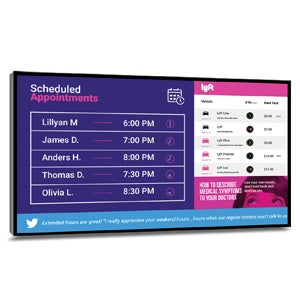
Public view
Adding transit options to hospital-signage kiosks provides patients and guests with easily visible transit information to help make their visit less stressful. Mvix Digital Signage
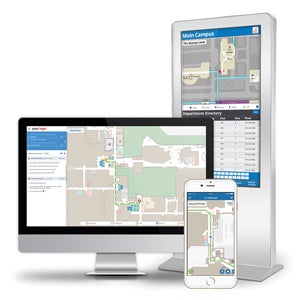
Clear communication
Integrated platforms help organizations communicate a clear and unified message to all patients. LogicJunction Inc.
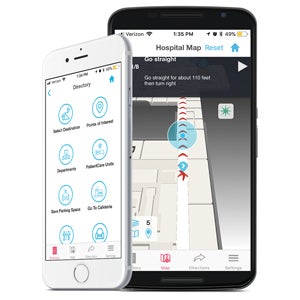
Multiple routes
MediNav is an all-screens solution that enables users to get maps and directions across multiple platforms. Connexient Inc.

Staying power
Touchscreen kiosk directories, such as the one pictured above, are fast becoming the standard in hospitals Cooper Signage & Graphics Inc.

The right direction
Combined with a directory application, wayfinding screens can help patients find offices or departments, and navigate to them with ease. Four Winds Interactive
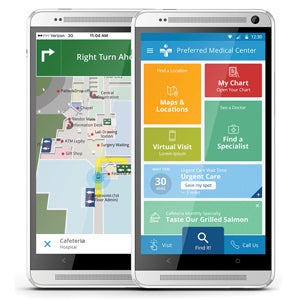
Easy street
This smartphone-based wayfinding platform is specifically designed for hospitals, transforms indoor navigation and improves the patient experience. Gozio Health


